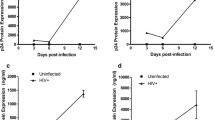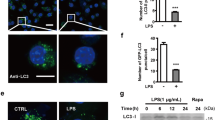Abstract
Toll-like receptor 2 (TLR2) regulates the innate immune response of microglia during infection via autophagy. Microglial M1/M2 phenotypic switching after infection could serve as a novel pathogenic mechanism for cerebral infection. Hence, it has important implications for the damage and restoration of neurological function. However, the effect of TLR2-mediated autophagic signaling on microglial phenotypic transition remains unclear. Therefore, we investigated the mechanisms of TLR2-mediated autophagic signaling in the regulation of microglial M1/M2 phenotypes. Using Western blot analysis and immunofluorescence, increased autophagy was observed in peptidoglycan (PGN)-stimulated BV2 cells, while reduced autophagy was observed in TLR2-KO cells. In contrast to the TLR2 antagonist CU-CPT22 group, increased autophagy was observed in the presence of the TLR2 agonist Pam3CSK4, which was associated with a significant increase in expression levels of M1 phenotype biomarkers (CD86, TNF-α, IL-6), higher levels of apoptosis, and decreased expression levels of M2 markers (CD206, IL-10, Arg-1). In the TLR2-KO mice, the expression levels of autophagy-related proteins in CD11b+ cells were lower than those in CD11b+ cells in the PGN-injected wild-type mice, and neuronal apoptosis was also reduced, but there were no significant differences compared to the control group. Collectively, our study demonstrates that the inhibition of autophagy or the absence of TLR2 induces microglial polarization towards the M2 phenotype, promotes microglial survival alone, and alleviates the development of neuroinflammation. In summary, TLR2-mediated autophagic signaling contributes to regulating the inflammatory response to activate microglial M1/M2 switching, which affects microglial survival after infection.




Similar content being viewed by others
Data Availability
The data that support the findings of this study are available from the corresponding author upon reasonable request.
References
McWhorter, F.Y., T. Wang, P. Nguyen, T. Chung, and W.F. Liu. 2013. Modulation of macrophage phenotype by cell shape. Proceedings of the National Academy of Sciences of the United States of America 110 (43): 17253–17258.
Kobayashi, K., S. Imagama, T. Ohgomori, K. Hirano, K. Uchimura, K. Sakamoto, et al. 2013. Minocycline selectively inhibits M1 polarization of microglia. Cell Death & Disease 4: e525.
Xia, C.Y., S. Zhang, S.F. Chu, Z.Z. Wang, X.Y. Song, W. Zuo, Y. Gao, P.F. Yang, and N.H. Chen. 2016. Autophagic flux regulates microglial phenotype according to the time of oxygen-glucose deprivation/reperfusion. International Immunopharmacology 39: 140–148.
Hu, X., R.K. Leak, Y. Shi, J. Suenaga, Y. Gao, P. Zheng, and J. Chen. 2015. Microglial and macrophage polarization-new prospects for brain repair. Nature Reviews. Neurology 11 (1): 56–64.
Yao, X., S. Liu, W. Ding, P. Yue, Q. Jiang, M. Zhao, et al. 2017. TLR4 signal ablation attenuated neurological deficits by regulating microglial M1/M2 phenotype after traumatic brain injury in mice. Journal of Neuroimmunology 310: 38–45.
Machado-Pereira, M., T. Santos, L. Ferreira, L. Bernardino, and R. Ferreira. 2017. Anti-inflammatory strategy for M2 microglial polarization using retinoic acid-loaded nanoparticles. Mediators of Inflammation 2017: 6742427.
Nicolas, S., J. Cazareth, H. Zarif, A. Guyon, C. Heurteaux, J. Chabry, et al. 2017. Globular adiponectin limits microglia pro-inflammatory phenotype through an AdipoR1/NF-kappaB signaling pathway. Frontiers in Cellular Neuroscience 11: 352.
Zhou, T., Z. Huang, X. Sun, X. Zhu, L. Zhou, M. Li, et al. 2017. Microglia polarization with M1/M2 phenotype changes in rd1 mouse model of retinal degeneration. Frontiers in Neuroanatomy 11: 77.
Aryanpour, R., P. Pasbakhsh, K. Zibara, Z. Namjoo, F. Beigi Boroujeni, S. Shahbeigi, et al. 2017. Progesterone therapy induces an M1 to M2 switch in microglia phenotype and suppresses NLRP3 inflammasome in a cuprizone-induced demyelination mouse model. International Immunopharmacology 51: 131–139.
Qin, C., W.H. Fan, Q. Liu, K. Shang, M. Murugan, L.J. Wu, W. Wang, and D.S. Tian. 2017. Fingolimod protects against ischemic white matter damage by modulating microglia toward M2 polarization via STAT3 pathway. Stroke 48 (12): 3336–3346.
Bussi, C., J.M. Peralta Ramos, D.S. Arroyo, E.A. Gaviglio, J.I. Gallea, J.M. Wang, et al. 2017. Autophagy down regulates pro-inflammatory mediators in BV2 microglial cells and rescues both LPS and alpha-synuclein induced neuronal cell death. Scientific Reports 7: 43153.
He, Y., H. She, T. Zhang, H. Xu, L. Cheng, M. Yepes, Y. Zhao, and Z. Mao. 2018. p38 MAPK inhibits autophagy and promotes microglial inflammatory responses by phosphorylating ULK1. The Journal of Cell Biology 217 (1): 315–328.
Mizushima, N., and M. Komatsu. 2011. Autophagy: Renovation of cells and tissues. Cell 147 (4): 728–741.
Carneiro, L.A., and L.H. Travassos. 2013. The interplay between NLRs and autophagy in immunity and inflammation. Frontiers in Immunology 4: 361.
Kim, J.Y., J.C. Paton, D.E. Briles, D.K. Rhee, and S. Pyo. 2015. Streptococcus pneumoniae induces pyroptosis through the regulation of autophagy in murine microglia. Oncotarget 6 (42): 44161–44178.
Guo, J.Y., B. Xia, and E. White. 2013. Autophagy-mediated tumor promotion. Cell 155 (6): 1216–1219.
Mehrpour, M., A. Esclatine, I. Beau, and P. Codogno. 2010. Overview of macroautophagy regulation in mammalian cells. Cell Research 20 (7): 748–762.
Jiang, P., and N. Mizushima. 2014. Autophagy and human diseases. Cell Research 24: 69–79.
Nixon, R.A., and D.S. Yang. 2011. Autophagy failure in Alzheimer’s disease—locating the primary defect. Neurobiology of Disease 43 (1): 38–45.
Saitoh, T., and S. Akira. 2010. Regulation of innate immune responses by autophagy-related proteins. The Journal of Cell Biology 189 (6): 925–935.
Su, P., J. Zhang, D. Wang, F. Zhao, Z. Cao, M. Aschner, and W. Luo. 2016. The role of autophagy in modulation of neuroinflammation in microglia. Neuroscience 319: 155–167.
Ribes, S., S. Ebert, T. Regen, A. Agarwal, S.C. Tauber, D. Czesnik, et al. 2010. Toll-like receptor stimulation enhances phagocytosis and intracellular killing of nonencapsulated and encapsulated Streptococcus pneumoniae by murine microglia. Infection and Immunity 78 (2): 865–871.
Hug, H., M.H. Mohajeri, and G. La Fata. 2018. Toll-like receptors: Regulators of the immune response in the human gut. Nutrients 10 (2).
Liu, X., Q. Han, and J. Leng. 2014. Analysis of nucleotide-binding oligomerization domain proteins in a murine model of pneumococcal meningitis. BMC Infectious Diseases 14: 648.
Texereau, J., J.D. Chiche, W. Taylor, G. Choukroun, B. Comba, and J.P. Mira. 2005. The importance of Toll-like receptor 2 polymorphisms in severe infections. Clinical Infectious Diseases 41 (Suppl 7): S408–S415.
Arroyo, D.S., J.A. Soria, E.A. Gaviglio, C. Garcia-Keller, L.M. Cancela, M.C. Rodriguez-Galan, J.M. Wang, and P. Iribarren. 2013. Toll-like receptor 2 ligands promote microglial cell death by inducing autophagy. The FASEB Journal 27 (1): 299–312.
Fang, L., H.M. Wu, P.S. Ding, and R.Y. Liu. 2014. TLR2 mediates phagocytosis and autophagy through JNK signaling pathway in Staphylococcus aureus-stimulated RAW264.7 cells. Cellular Signalling 26 (4): 806–814.
Shin, D.M., J.M. Yuk, H.M. Lee, S.H. Lee, J.W. Son, C.V. Harding, J.M. Kim, R.L. Modlin, and E.K. Jo. 2010. Mycobacterial lipoprotein activates autophagy via TLR2/1/CD14 and a functional vitamin D receptor signalling. Cellular Microbiology 12 (11): 1648–1665.
Lu, Z., D. Xie, Y. Chen, E. Tian, I. Muhammad, X. Chen, Y. Miao, W. Hu, Z. Wu, H. Ni, J. Xin, Y. Li, and J. Li. 2017. TLR2 mediates autophagy through ERK signaling pathway in Mycoplasma gallisepticum-infected RAW264.7 cells. Molecular Immunology 87: 161–170.
Shen, Q., X. Zhang, Q. Li, J. Zhang, H. Lai, H. Gan, X. du, and M. Li. 2019. TLR2 protects cisplatin-induced acute kidney injury associated with autophagy via PI3K/Akt signaling pathway. Journal of Cellular Biochemistry 120 (3): 4366–4374.
Poluzzi, C., M.V. Nastase, J. Zeng-Brouwers, H. Roedig, L.T. Hsieh, J.B. Michaelis, et al. 2019. Biglycan evokes autophagy in macrophages via a novel CD44/Toll-like receptor 4 signaling axis in ischemia/reperfusion injury. Kidney Int 95 (3): 540–562.
Masuda, T., and M. Prinz. 2016. Microglia: A unique versatile cell in the central nervous system. ACS Chemical Neuroscience 7 (4): 428–434.
Liu, X., V.S. Chauhan, A.B. Young, and I. Marriott. 2010. NOD2 mediates inflammatory responses of primary murine glia to Streptococcus pneumoniae. Glia 58 (7): 839–847.
Kielian, T., and W.F. Hickey. 2000. Proinflammatory cytokine, chemokine, and cellular adhesion molecule expression during the acute phase of experimental brain abscess development. The American Journal of Pathology 157 (2): 647–658.
Kielian, T., A. Haney, P.M. Mayes, S. Garg, and N. Esen. 2005. Toll-like receptor 2 modulates the proinflammatory milieu in Staphylococcus aureus-induced brain abscess. Infection and Immunity 73 (11): 7428–7435.
Arroyo, D.S., E.A. Gaviglio, J.M. Peralta Ramos, C. Bussi, M.P. Avalos, L.M. Cancela, et al. 2018. Phosphatidyl-inositol-3 kinase inhibitors regulate peptidoglycan-induced myeloid leukocyte recruitment, inflammation, and neurotoxicity in mouse brain. Frontiers in Immunology 9: 770.
Xin, X.Y., J. Pan, X.Q. Wang, J.F. Ma, J.Q. Ding, G.Y. Yang, and S.D. Chen. 2011. 2-Methoxyestradiol attenuates autophagy activation after global ischemia. The Canadian Journal of Neurological Sciences 38 (4): 631–638.
Wang, P., Y.F. Guan, H. Du, Q.W. Zhai, D.F. Su, and C.Y. Miao. 2012. Induction of autophagy contributes to the neuroprotection of nicotinamide phosphoribosyltransferase in cerebral ischemia. Autophagy 8 (1): 77–87.
Button, R.W., S. Luo, and D.C. Rubinsztein. 2015. Autophagic activity in neuronal cell death. Neuroscience Bulletin 31 (4): 382–394.
Ginet, V., M.P. Pittet, C. Rummel, M.C. Osterheld, R. Meuli, P.G. Clarke, et al. 2014. Dying neurons in thalamus of asphyxiated term newborns and rats are autophagic. Annals of Neurology 76 (5): 695–711.
Moehle, M.S., and A.B. West. 2015. M1 and M2 immune activation in Parkinson’s disease: Foe and ally? Neuroscience 302: 59–73.
Jin, M.M., F. Wang, D. Qi, W.W. Liu, C. Gu, C.J. Mao, et al. 2018. A critical role of autophagy in regulating microglia polarization in neurodegeneration. Frontiers in Aging Neuroscience 10: 378.
Funding
This work was supported by the National Natural Science Foundation (Project no. 31571557).
Author information
Authors and Affiliations
Contributions
Xinjie Liu: study conception and design; Kun Ma: experiments and manuscript writing; Jingjing Guo: data collection and analysis; Guan Wang and Qiuying Ni: material preparation and data collection
All authors read and approved the final manuscript.
Corresponding author
Ethics declarations
Conflict of Interest
The authors declare that they have no conflict of interest.
Ethical Approval
The experiments complied with the Regulations of the Administration of Laboratory Animals of the Ministry of Health of China (Document No. 55 of 2001) and were approved by the Animal Ethics Committee of Shandong University, China.
Additional information
Publisher’s Note
Springer Nature remains neutral with regard to jurisdictional claims in published maps and institutional affiliations.
Main Points
• Transition from the M1 to the M2 phenotype promotes microglial survival.
• Autophagy is associated with the M1 phenotype and increased apoptosis.
• Inhibition or absence of TLR2 is associated with reduced autophagy.
Rights and permissions
About this article
Cite this article
Ma, K., Guo, J., Wang, G. et al. Toll-Like Receptor 2–Mediated Autophagy Promotes Microglial Cell Death by Modulating the Microglial M1/M2 Phenotype. Inflammation 43, 701–711 (2020). https://doi.org/10.1007/s10753-019-01152-5
Published:
Issue Date:
DOI: https://doi.org/10.1007/s10753-019-01152-5




